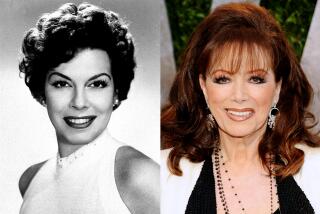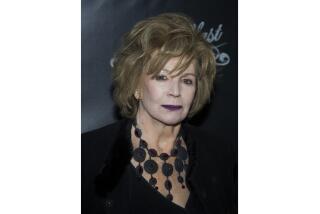Plums From Mary’s Cake : MARY McCARTHY A Life <i> by Carol Gelderman (St. Martin’s Press: $24.95; 448 pp.)</i>
- Share via
Mary McCarthy wrote about her own early life years ago in a memoir and has just published the first volume of an exhaustive autobiography, with more volumes to follow. She has used many incidents and situations from her life in her fiction. Not too many years ago, she was the subject of a biography by Doris Grumbach.
In spite of all this information about McCarthy, her accomplishments are so enormous and her life so interesting that there’s still a lot to say. She has turned out eight volumes of fiction, including the best-selling “The Group”; written two classic books about the art and history of Venice and Florence; compiled reporting and comment from Saigon and Hanoi into two books; written a book on the trial of Capt. Ernest Medina, who ordered the destruction of My Lai; written still another book about the Watergate hearings; collected many of her essays on literature and her theatrical criticism into several books; plus the memoir and autobiography. And she’s still writing.
McCarthy, who was born in 1912, has had four husbands: Harold Johnsrud, whom she married right after Vassar in 1933; Edmund Wilson, whom she married in 1937 and with whom she lived stormily for several years; Robert Bowden Broadwater, eight years younger than she, who seems to have been good about helping her find time to write; and finally, James West, a foreign services officer, whom she married in 1961 when she was 49. It was the first time, she said, that she had ever been really in love.
She has reared a son, Reuel Wilson, and helped to rear three stepchildren. She managed households in Maine, Rhode Island, Connecticut, Paris, Italy, and on Cape Cod, all the while insisting on cooking from scratch with fresh ingredients. Besides that, she’s had fun--the book frequently mentions parties like the Christmas house party at Castine, Me., where the guests read aloud the English mystery plays, copies of which were obtained only after great trouble. She has kept up long and fruitful friendships with people like Hannah Arendt and Nicola Chiaromonte.
In this well-crafted biography, Carol Gelderman picks and chooses details from the records of that awful McCarthy childhood, so vividly recalled in “Memories of a Catholic Girlhood,” and fills in gaps. (Mary’s parents died in the influenza epidemic of 1918, leaving Mary and her three younger brothers to the truly harsh care of insensitive relatives. Escaping the hated uncle in Minneapolis, Mary was sent back to Seattle to live with her mother’s parents and finally attended an Episcopal boarding school where a teacher inspired her to go East to Vassar.)
When this book gets to McCarthy’s grown-up years--the territory that has not been so thoroughly explored--it becomes most interesting. Gelderman deftly uses excerpts from McCarthy’s letters to round out the outline.
Newly married and fresh from Vassar (where she and Elizabeth Bishop, Muriel Rukeyser and Eleanor Clark started a literary magazine, Con Spirito, that McCarthy had wanted to call The Battle Axe, she descended on New York and immediately became embroiled in controversy. In a series in The Nation, she flailed away at the book reviewers of the day, who, she said, were cheating the public. Burton Rascoe, for example, a celebrated critic, had said that “The Divine Comedy” was “no more worthy of admiration than a carved replica of the battleship Maine assembled inside a bottle,” but he found “Lo!” by Charles Fort one of the great books of the world. At 22, McCarthy had begun her lifelong war on the dull and the crass (she would write much later that “Eichmann was profoundly and egregiously stupid, and for me stupidity is not the same as having a low IQ and . . . stupidity is caused, not by brain failure, (but) by a wicked heart. Insensitivity, opacity, inability to make connections, often accompanied by low ‘animal’ cunning. One cannot help feeling that this mental oblivion is chosen--by the heart or the moral will.”)
Gelderman provides a brief but clear account of the effect the 1937 Moscow trials had on the New York intellectual community, with Trotskyites lined up against Stalinites. McCarthy said later that she felt like Stendahl’s hero, “who took part in the something confused and disarrayed and insignificant that he later learned was the Battle of Waterloo.” Enduring the ideological battle, although she did not realize it until later, changed her life.
McCarthy’s fiction often roused resentment and anger, mostly from the people who knew her and felt the novels portrayed them. The Partisan Review crowd felt pilloried in “The Oasis,” as did her Vassar classmates in “The Group”; she drew on her colleagues at Bard College for the hilarious “The Groves of Academe”; like the heroine of “A Charmed Life,” McCarthy and her new husband, Broadwater, returned to Wellfleet where her former husband, Wilson, lived, causing endless social complications. “What I really do is take real plums and put them in an imaginary cake,” McCarthy said. “If you’re interested in cake, you get rather annoyed with people saying what species the real plum was.” Later, she said that she knew her portrayals could hurt, but “I can’t stop myself. I go and do it and hope . . . that in the end they will forgive me.”
The author’s criticism of the novels seems sound, although I think their humor and wit are still not completely appreciated. She writes about McCarthy’s ideas on fiction, too, and one of the most fascinating passages in the biography describes the meticulous research that McCarthy carried on before writing “Cannibals and Missionaries.” She made several trips to Holland, where her activities ranged from visiting Parliament and interviewing the prime minister to checking the times of television programs. As Gelderman says, “She believes there cannot be anything in fiction that flies in the face of fact.”
More to Read
Sign up for our Book Club newsletter
Get the latest news, events and more from the Los Angeles Times Book Club, and help us get L.A. reading and talking.
You may occasionally receive promotional content from the Los Angeles Times.








